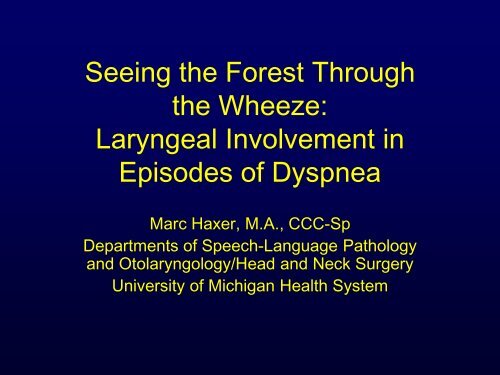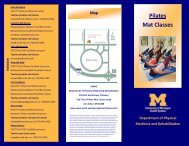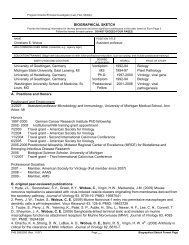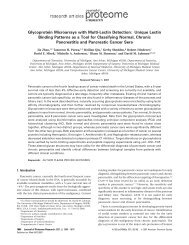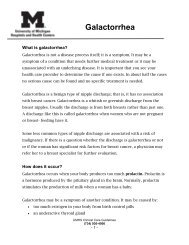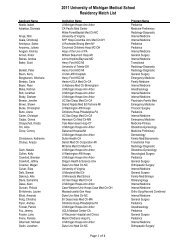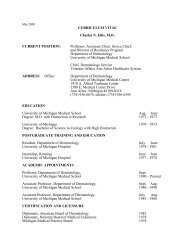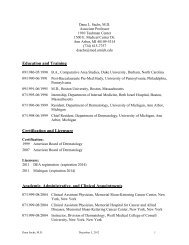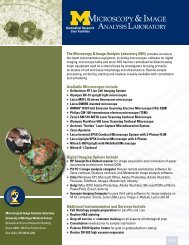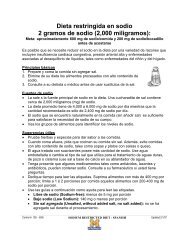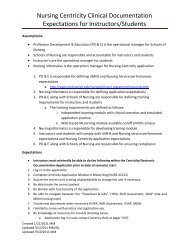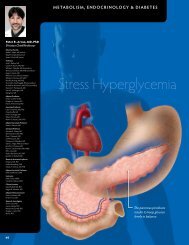Seeing the Forest Through the Wheeze: Laryngeal Involvement in ...
Seeing the Forest Through the Wheeze: Laryngeal Involvement in ...
Seeing the Forest Through the Wheeze: Laryngeal Involvement in ...
Create successful ePaper yourself
Turn your PDF publications into a flip-book with our unique Google optimized e-Paper software.
<strong>See<strong>in</strong>g</strong> <strong>the</strong> <strong>Forest</strong> <strong>Through</strong><br />
<strong>the</strong> <strong>Wheeze</strong>:<br />
<strong>Laryngeal</strong> <strong>Involvement</strong> <strong>in</strong><br />
Episodes of Dyspnea<br />
Marc Haxer, M.A., CCC-Sp<br />
Departments of Speech-Language Pathology<br />
and Otolaryngology/Head and Neck Surgery<br />
University of Michigan Health System
Introduction<br />
• Goals/Objectives<br />
– Become familiar with upper versus lower<br />
airway etiologies for dyspnea<br />
– Become able to differentially diagnose upper<br />
airway <strong>in</strong>volvement <strong>in</strong> dyspnea<br />
– Become familiar with chronic cough,<br />
<strong>in</strong>voluntary vocal fold closure, laryngospasm,<br />
adductory laryngeal breath<strong>in</strong>g dystonia and<br />
irritable larynx syndrome as <strong>the</strong>y relate to<br />
compromised respiration
Larynx<br />
• Cartilag<strong>in</strong>ous tube<br />
– Connects <strong>in</strong>feriorly to respiratory system<br />
• Trachea, lungs<br />
– Connects superiorly to vocal tract<br />
• Pharynx, oropharynx, nasopharynx<br />
• Anatomic orientation important<br />
– Highlights <strong>in</strong>teractive relationship between vocal<br />
subsystems<br />
• Pulmonary mechanism<br />
• <strong>Laryngeal</strong> valve<br />
• Supraglottic vocal tract resonator
Larynx<br />
• Complex arrangement of muscles, mucus<br />
membranes, and o<strong>the</strong>r connective tissue<br />
– Soft tissues responsible for airway preservation<br />
– Cartilage hous<strong>in</strong>g serves as columnar protective shield<br />
for laryngeal valve<br />
• Muscles and cartilages provide three levels of<br />
“folds”<br />
– Serve as sph<strong>in</strong>cters which provide communicative and<br />
vegetative functions<br />
– Angles of closure multidimensional (valve <strong>in</strong><br />
horizontal and vertical planes)
Larynx<br />
• Upper rim of larynx formed by<br />
aryepiglottic folds<br />
– Fibrous membrane extend<strong>in</strong>g from epiglottis<br />
to arytenoid towers<br />
– Thus serves as lateral boundary of larynx<br />
– Epiglottic <strong>in</strong>version posteriorly/<strong>in</strong>feriorly over<br />
laryngeal vestibule results <strong>in</strong> separation of<br />
larynx from pharynx and serves as most<br />
superior level of airway protection
Larynx<br />
• Second sph<strong>in</strong>cter formed by ventricular folds<br />
– Not normally active dur<strong>in</strong>g phonation<br />
– Can become hyperfunctional dur<strong>in</strong>g episodes of<br />
<strong>in</strong>creased vocal effort/extreme vegetative closure<br />
– Directly superior to ventricle/true vocal folds<br />
– Form double layer of medial closure w/TVFs if needed<br />
– Pr<strong>in</strong>ciple function is to <strong>in</strong>crease <strong>in</strong>trathoracic pressure<br />
by block<strong>in</strong>g exhalatory airflow from lungs<br />
– Compress tightly dur<strong>in</strong>g sneez<strong>in</strong>g/cough<strong>in</strong>g, lift<strong>in</strong>g,<br />
emesis, childbirth, defecation<br />
– Also provide medial level of airway protection dur<strong>in</strong>g<br />
swallows
Larynx<br />
• Most <strong>in</strong>feriorly are true vocal folds<br />
– Provide vibrat<strong>in</strong>g source for phonation<br />
– Also close tightly for nonspeech and vegetative tasks<br />
• Thus, larynx and vocal folds function as variable<br />
valve<br />
– Modulate airflow through VFs dur<strong>in</strong>g phonation<br />
– Close off trachea/lungs to prevent soil<strong>in</strong>g of airway<br />
dur<strong>in</strong>g swallows<br />
– Provide resistance to <strong>in</strong>creased abdom<strong>in</strong>al pressure<br />
dur<strong>in</strong>g effortful activities
Neurologic Supply<br />
• Cranial nerve X <strong>in</strong>nervates larynx<br />
peripherally<br />
– Vagus = “wanderer”<br />
– Innervates sites from skull to abdomen<br />
• Innervates larynx through two important<br />
branches<br />
– Superior laryngeal nerve (SLN)<br />
– Recurrent laryngeal nerve (RLN)
Neurologic Supply<br />
• Superior laryngeal nerve<br />
– Branches off vagus near nodose ganglia <strong>in</strong><br />
neck<br />
– Course alongside carotid artery<br />
– Forms <strong>in</strong>ternal/external branches<br />
• Internal branch <strong>in</strong>serts through thyrohyoid<br />
membrane superior to VFs and provides all sensory<br />
<strong>in</strong>formation to larynx<br />
• External branch is motor nerve to cricothyroid (CT)<br />
muscle
Neurologic Supply<br />
• Recurrent laryngeal nerve<br />
– Extends to thorax<br />
– Forms long loop under heart before cours<strong>in</strong>g<br />
superiorly under thyroid gland and <strong>in</strong>to larynx<br />
– Different on right/left sides of body<br />
• L RLN courses under aorta<br />
• R RLN course under subclavian artery<br />
– Nerves (especially left) susceptible to <strong>in</strong>jury<br />
– Supplies all sensory <strong>in</strong>formation to area below VFs<br />
and all motor <strong>in</strong>nervation to PCA, TA, LCA, and IA<br />
muscles
Larynx
Where/What’s <strong>the</strong> Problem?<br />
• Upper airway issue?<br />
• Lower airway issue?<br />
• Problem w/<strong>in</strong>halation?<br />
• Problem w/exhalation?<br />
• Problem w/both?<br />
• Acute versus chronic issue?<br />
• Episodes same/different w/regard to<br />
presentation?<br />
• Episodes same/different w/regard to severity?
Upper Airway Issues that can<br />
Compromise Respiration<br />
• Unilateral vocal fold motion impairment (abductory)<br />
• Bilateral vocal fold motion impairment (abductory)<br />
• Re<strong>in</strong>ke’s edema<br />
• <strong>Laryngeal</strong> papilloma<br />
• <strong>Laryngeal</strong> carc<strong>in</strong>oma<br />
• Vocal Fold Granuloma<br />
• Laryngospasm<br />
• Involuntary vocal fold closure<br />
• Cough<br />
• Adductory <strong>Laryngeal</strong> Breath<strong>in</strong>g Dystonia<br />
• Acute <strong>in</strong>fection (eg croup, laryngitis, epiglottitis)<br />
• Allergies<br />
• Laryngomalacia<br />
• Tracheomalacia/Stenosis<br />
• Foreign body <strong>in</strong> airway<br />
• Extr<strong>in</strong>sic/<strong>in</strong>tr<strong>in</strong>sic airway compression by tumor <strong>in</strong>ferior to glottis
Unilateral Vocal Fold Paralysis
Bilateral Vocal Fold Paralysis
Re<strong>in</strong>ke’s Edema
<strong>Laryngeal</strong> Papilloma
<strong>Laryngeal</strong> Carc<strong>in</strong>oma
Vocal Fold Granuloma
Laryngitis
Laryngomalacia
Tracheal Stenosis
Lower Airway Issues that can<br />
• Asthma<br />
• COPD<br />
• Emphysema<br />
Compromise Respiration<br />
• Restrictive Airway Disease<br />
• Lung Cancer<br />
• Interstitial lung disease
Chronic Illnesses/Disorders That<br />
Can Affect <strong>Laryngeal</strong> Function<br />
• Chronic s<strong>in</strong>usitis/URI<br />
– Cough/throat clear<br />
• Can cause trauma to laryngeal tissues<br />
– Antihistam<strong>in</strong>es<br />
• Dry secretions<br />
• Resultant dehydration of VFs<br />
– Anti-cough medications<br />
• Dry<strong>in</strong>g agents<br />
• Contribute to VF dehydration
Chronic Illnesses/Disorders That<br />
Can Affect <strong>Laryngeal</strong> Function<br />
• Asthma<br />
• Chronic obstructive pulmonary disease<br />
• Emphysema<br />
• Lung CA<br />
– Above can be direct/<strong>in</strong>direct cause of laryngeal<br />
problems<br />
• Vocal fold tissue abuse<br />
• Poor breath support<br />
• Vocal fold dryness secondary to medication use<br />
• VF paresis/paralysis<br />
• Cough
Chronic Illnesses/Disorders That<br />
Can Affect <strong>Laryngeal</strong> Function<br />
• Allergies<br />
– Congestion/edema of VFs<br />
– VF dehydration<br />
– VF tissue trauma<br />
• cough/throat clear
Chronic Illnesses/Disorders That<br />
Can Affect <strong>Laryngeal</strong> Function<br />
• Laryngopharyngeal reflux disease<br />
– Is GERD that affects pharynx/larynx<br />
– Occult chronic reflux is etiologic factor <strong>in</strong> high<br />
percentage of patients w/laryngologic compla<strong>in</strong>ts<br />
– Reflux <strong>in</strong>volves multiple anatomic sites<br />
• LES<br />
• Entire esophagus<br />
• UES<br />
• Larynx/pharynx/oral cavity<br />
• Trachea<br />
• Lungs
Chronic Illnesses/Disorders That<br />
Can Affect <strong>Laryngeal</strong> Function<br />
• Laryngopharyngeal reflux disease<br />
– Symptoms<br />
• Chronic hoarseness<br />
• Voice fatigue<br />
• Cough<br />
• Chronic throat clear<strong>in</strong>g<br />
• Globus sensation<br />
• Sensation of chok<strong>in</strong>g<br />
• Edema<br />
• Ulceration/granulation of laryngeal mucosa<br />
• Hyperkeratosis<br />
• Carc<strong>in</strong>oma of larynx
Chronic Illnesses/Disorders That<br />
Can Affect <strong>Laryngeal</strong> Function<br />
• Laryngopharyngeal reflux disease<br />
– LPRD best managed via multidiscipl<strong>in</strong>ary team<br />
• Otolaryngologist<br />
• Internist/PCP<br />
• Gastroenterologist<br />
• Allergist<br />
• Pulmonologist<br />
• Speech Pathologist<br />
• Nutritionist
Chronic Illnesses/Disorders That<br />
Can Affect <strong>Laryngeal</strong> Function<br />
• Laryngopharyngeal reflux disease<br />
– Almost always associated w/some degree of<br />
aspiration<br />
• Amount of aspiration may be cl<strong>in</strong>ically <strong>in</strong>significant<br />
• Or, may be cl<strong>in</strong>ically significant enough to cause:<br />
– Chronic cough<br />
– Involuntary vocal fold closure<br />
– Reactive airway disease<br />
– Difficult to control asthma<br />
– Pneumonia<br />
– Bronchiectasis
Chronic Illnesses/Disorders That<br />
Can Affect <strong>Laryngeal</strong> Function<br />
• Laryngopharyngeal reflux disease<br />
– Evaluation<br />
• Esophagram<br />
• Dual 24-hour pH probe<br />
• Bravo capsule study<br />
• Flexible fiberoptic endoscopy
Chronic Illnesses/Disorders That<br />
Can Affect <strong>Laryngeal</strong> Function<br />
• Laryngopharyngeal reflux disease<br />
– Treatment<br />
• Behavioral<br />
• Chewable antacids<br />
• Viscous antacids<br />
• H2-receptor antagonists<br />
• Proton pump <strong>in</strong>hibitors<br />
• Nissen fundoplication/Stretta procedure
Chronic Illnesses/Disorders That<br />
Can Affect <strong>Laryngeal</strong> Function<br />
• Smok<strong>in</strong>g/alcohol abuse/illicit drug use<br />
– Ery<strong>the</strong>ma/edema<br />
– Generalized <strong>in</strong>flammation<br />
– Dry<strong>in</strong>g of mucous membranes<br />
– Incoord<strong>in</strong>ation/dysarthria/impaired judgment<br />
– LPRD<br />
– Chronic cough
Primary Disorder Etiologies That<br />
Can Affect <strong>Laryngeal</strong> Function<br />
• Environmental stress<br />
– Loss of employment<br />
– Death of spouse/significant o<strong>the</strong>r<br />
– Family conflict<br />
• Conversion behaviors<br />
– Avoidance behavior(s) developed to counteract stressful<br />
situation(s)<br />
– Whisper<strong>in</strong>g, muteness, unusual dysphonias<br />
• Identity conflict<br />
– Establishment of own personality<br />
• High-pitched falsetto <strong>in</strong> post-pubescent adolescent<br />
• Weak, juvenile, th<strong>in</strong>-sound<strong>in</strong>g voice of adult female<br />
• Raised pitch <strong>in</strong> male-to-female transsexual
Case Study #1<br />
• 41 year-old female<br />
• Present<strong>in</strong>g Dx of “difficult to control asthma”<br />
• Trialed on multiple courses of different asthma<br />
medications over a # of months w/no appreciable<br />
improvement <strong>in</strong> respiratory function<br />
• No hx of smok<strong>in</strong>g/excessive alcohol use<br />
• Present<strong>in</strong>g symptoms<br />
– Chronic sense of chest tightness<br />
– Chronic restriction of <strong>in</strong>halation/exhalation<br />
– Sense of “elephant sitt<strong>in</strong>g on chest”<br />
– Chronic hoarseness X12 months w/no Otolaryngologic<br />
exam<strong>in</strong>ation<br />
– Denied sense of throat constriction
Case Study #1<br />
• Present<strong>in</strong>g symptoms not consistent with<br />
upper airway <strong>in</strong>volvement<br />
• Extended duration of hoarseness<br />
concern<strong>in</strong>g<br />
• Referral to Otolaryngology<br />
• Fiberoptic endoscopic exam results<br />
– Marked endolaryngeal ery<strong>the</strong>ma/edema<br />
– <strong>Laryngeal</strong> candidiasis<br />
– No concern<strong>in</strong>g lesions
• Treatment<br />
Case Study #1<br />
– Speech Pathology not <strong>in</strong>volved <strong>in</strong> Tx<br />
– Aggressive pharmacologic management of<br />
LPRD/candidiasis for six months<br />
• Oral anti-fungal medication (swish/swallow)<br />
• Anti-reflux management<br />
– Rigid behavioral strategies<br />
– 40mg PPI b.i.d. 30 m<strong>in</strong>utes prior to oral <strong>in</strong>take
• Results of treatment<br />
– 40 lb. weight loss<br />
Case Study #1<br />
– Return of basel<strong>in</strong>e vocal function<strong>in</strong>g<br />
– Return of basel<strong>in</strong>e respiratory function<strong>in</strong>g<br />
– Secondary to tx, QOL markedly improved
Irritable Larynx Syndrome<br />
Chronic Throat<br />
Clear<strong>in</strong>g<br />
Chronic Cough<br />
IVFC<br />
Laryngospasm
Irritable Larynx Syndrome<br />
• Postulated by Morrison, Rammage, and<br />
Emami <strong>in</strong> 1999<br />
• Suggests that various laryngeal behaviors<br />
can be categorized with<strong>in</strong> <strong>the</strong> context of<br />
“hyperk<strong>in</strong>etic laryngeal dysfunction”
These Behaviors Include:<br />
• Muscle Tension Dysphonia<br />
• Episodic laryngospasm<br />
• Globus sensation<br />
• Cough
Muscle Tension Dysphonia<br />
• Incoord<strong>in</strong>ation between respiration and<br />
phonation<br />
• Above results <strong>in</strong> elevated levels of<br />
laryngeal/throat muscle tension<br />
• In turn, contributes to general laryngeal<br />
hyperfunction<br />
– <strong>Laryngeal</strong> pa<strong>in</strong>/discomfort<br />
– Increased vocal effort<br />
– Vocal fatigue
Muscle Tension Dysphonia<br />
• In addition to elevated levels of tension <strong>in</strong><br />
larynx/throat, can also contribute to<br />
<strong>in</strong>creased tension <strong>in</strong> neck, shoulder, and<br />
upper chest musculature<br />
– Can <strong>the</strong>n masquerade as sensation of limited<br />
movement of air through <strong>the</strong> neck/throat area<br />
dur<strong>in</strong>g <strong>in</strong>halation
Episodic Laryngospasm<br />
• Adduction of VFs dur<strong>in</strong>g <strong>in</strong>halatory phase of respiration<br />
• In differential Dx<br />
– Involuntary Vocal Fold Closure<br />
– Adductory <strong>Laryngeal</strong> Breath<strong>in</strong>g Dystonia<br />
– Closure of VFs as protective mechanism dur<strong>in</strong>g reflux episode<br />
• Somatoform/anxiety disorder?<br />
– Intr<strong>in</strong>sic/extr<strong>in</strong>sic stress vs. psychological issue<br />
– Larynx “Achilles heel” for stress/anxiety?<br />
• Variations on a <strong>the</strong>me?<br />
– Asthma variant<br />
• Functional?<br />
– Implies normal structure/function of larynx but <strong>in</strong>appropriate behavior<br />
of <strong>the</strong> same
Globus<br />
• “Lump <strong>in</strong> throat” sensation<br />
• Secondary to <strong>in</strong>creased levels of muscle<br />
tension <strong>in</strong> larynx?<br />
– Inappropriate rest<strong>in</strong>g or hold<strong>in</strong>g position of<br />
laryngeal musculature<br />
• Secondary to laryngopharyngeal reflux<br />
disease?<br />
– <strong>Laryngeal</strong> ery<strong>the</strong>ma/edema masquerad<strong>in</strong>g as<br />
sensation of mucous
Cough<br />
• Secondary to respiratory disease?<br />
– Acute vs. chronic<br />
– Productive vs. non-productive<br />
• Secondary to laryngopharyngeal reflux disease?<br />
• Increase <strong>in</strong> stress/anxiety?<br />
– Stress vs. psychogenic<br />
– Functional?<br />
• Secondary to allergies?<br />
• Neuropathic?
For All of These Behaviors<br />
• Larynx appears structurally normal on<br />
visualization<br />
• Abnormal laryngeal muscle posture<br />
present<br />
– Anteroposterior “squeeze” of laryngeal<br />
complex<br />
• Palpable laryngeal muscle tension present<br />
– Massage of thyroid cartilage/hyoid bone<br />
results <strong>in</strong> pa<strong>in</strong>, discomfort
Irritable Larynx Syndrome<br />
• Def<strong>in</strong>ed as:<br />
– “hyperk<strong>in</strong>etic laryngeal dysfunction result<strong>in</strong>g<br />
from an assorted collection of causes <strong>in</strong><br />
response to a def<strong>in</strong>itive trigger<strong>in</strong>g stimulus”
ILS – Inclusion Criteria<br />
• Symptoms attributable to laryngeal tension<br />
– Dysphonia and/or laryngospasm<br />
• With or without chronic cough<br />
• Visible and palpable evidence of tension<br />
– Lateral and A/P compression of larynx dur<strong>in</strong>g<br />
laryngoscopic exam<strong>in</strong>ation<br />
– Discomfort dur<strong>in</strong>g laryngeal palpation<br />
• Presence of sensory trigger(s)<br />
– Airborne substance<br />
– Esophageal irritant<br />
– Odors
ILS – Exclusion Criteria<br />
• Apparent organic laryngeal pathology<br />
• Identifiable neurologic disease<br />
• Identifiable psychiatric diagnosis
Patients with Dx of ILS<br />
• Tend to have complex comb<strong>in</strong>ation of signs,<br />
symptoms, and background factors<br />
• Laryngospasm and dysphonia are two major ILS<br />
symptoms<br />
– Laryngospasm most distress<strong>in</strong>g to patient<br />
• More m<strong>in</strong>or symptoms<br />
– Globus<br />
– Cough<br />
– Perilaryngeal pa<strong>in</strong><br />
• Above will vary from patient to patient
ILS Symptom Complex Group<strong>in</strong>g<br />
• Laryngospasm alone<br />
• Laryngospasm with dysphonia, globus, or<br />
cough<br />
• Dysphonia alone<br />
• Dysphonia with laryngospasm, globus, or<br />
cough<br />
• O<strong>the</strong>r<br />
– Globus and/or cough
• Airborne irritants<br />
• Reflux<br />
Trigger<strong>in</strong>g Stimuli<br />
• Perfumes/colognes<br />
• Foods<br />
• Emotions<br />
• Voice use<br />
• Exertion
• Reflux<br />
• Viral<br />
Possible Etiologic Factors<br />
• Stress/Psychogenic<br />
• Asthma<br />
• Environmental allergy(ies)<br />
• Torsion <strong>in</strong>jury to neck/throat/larynx
Hypo<strong>the</strong>sis for ILS<br />
• Develops as reaction to some sort of CNS change that<br />
leaves sensorimotor pathways <strong>in</strong> state of hypersensitivity<br />
• # of possible causative factors<br />
• Several can be active <strong>in</strong> any one patient<br />
• Most prevalent<br />
– Emotional distress<br />
• Stress component vs. psychogenic cause<br />
– Habitual <strong>in</strong>appropriate rest<strong>in</strong>g posture of laryngeal musculature<br />
– LPRD<br />
– Post-viral illness<br />
• Viral neuropathy
Treatment<br />
• Reflux management<br />
– Behavioral/pharmacologic<br />
• Exercises<br />
• Stress management<br />
• Massage/manipulation<br />
• Non-reflux pharmacologic management<br />
– Botul<strong>in</strong>um Tox<strong>in</strong> A<br />
– Nebulized topical anes<strong>the</strong>tic<br />
– Amitriptyl<strong>in</strong>e/Gabepent<strong>in</strong>
Cough<br />
• Important respiratory defense mechanism<br />
• Responsible for clearance of excessive<br />
secretions, fluids, or foreign materials<br />
from <strong>the</strong> airway<br />
• Despite this protective role, excessive<br />
cough<strong>in</strong>g can result <strong>in</strong> multisystem issues<br />
– Anxiety, dysphonia, fatigue, ur<strong>in</strong>ary<br />
<strong>in</strong>cont<strong>in</strong>ence, emesis, rib fracture(s), etc.
Cough – Differential Diagnosis<br />
• Upper Respiratory<br />
Tract<br />
• Allergic or vasomotor<br />
rh<strong>in</strong>itis, postnasal drip<br />
syndrome,<br />
<strong>in</strong>fectious/post<strong>in</strong>fectious<br />
cough,<br />
s<strong>in</strong>usitis
Cough – Differential Diagnosis<br />
• Lower Respiratory Tract • Abscess, allergic<br />
<strong>in</strong>flammation, aspiration,<br />
asthma, bronchiectasis,<br />
bronchitis, COPD, cystic<br />
fibrosis, drugs,<br />
eos<strong>in</strong>ophilic bronchitis,<br />
<strong>in</strong>terstitial lung disease,<br />
pertussis, primary or<br />
metastatic lung tumors,<br />
sarcoidosis, tuberculosis
Cough – Differential Diagnosis<br />
• Cardiovascular system<br />
• Gastro<strong>in</strong>test<strong>in</strong>al<br />
system<br />
• Left ventricular<br />
failure, mitral<br />
stenosis, medications<br />
(ACE <strong>in</strong>hibitors)<br />
• Reflux disease<br />
(laryngopharyngeal)
Cough – Differential Diagnosis<br />
• Central Nervous<br />
System (psychological<br />
response)<br />
• D’Urzo and Jugovic (2002)<br />
• Habit cough, chronic<br />
cough, psychogenic<br />
cough, neuropathic<br />
cough
Cough – Cl<strong>in</strong>ical Presentation<br />
• School age children to older adults<br />
• Average length of cough months to years<br />
• Most pts have attempted multiple<br />
<strong>in</strong>terventions w/o resolv<strong>in</strong>g of cough<br />
• Most have associated fatigue<br />
• Most do not have accompany<strong>in</strong>g<br />
hoarseness<br />
• Most have been treated for reflux for a<br />
short period of time w/o success
Cough<br />
• Habit/chronic cough<br />
– Larynx engaged <strong>in</strong> disordered loop of behavior<br />
• Psychogenic cough<br />
– Cough occurs secondary to emotional/psychological issues<br />
• <strong>Laryngeal</strong> hypersensitivity/hyper-reactivity<br />
– Larynx over-reacts to trigger<strong>in</strong>g stimuli secondary to irritation of<br />
<strong>the</strong> larynx by refluxed stomach contents<br />
• Neuropathic cough<br />
– Cough occurs secondary to viral neuropathy<br />
• Cough Hypersensitivity Syndrome (Morice, 2009)<br />
– Th2-type immune response vs. reflux symptoms
Behavioral/Environmental History<br />
• Nature of cough<br />
– Light dry coughs throughout <strong>the</strong> day<br />
– Severe/overwhelm<strong>in</strong>g cough “attacks”<br />
• Pattern of cough<br />
– Occurs at specific time(s) of day?<br />
– Follow meals or specific activity(ies)?<br />
– Gett<strong>in</strong>g worse/rema<strong>in</strong><strong>in</strong>g stable?<br />
• Work/home/social environment<br />
– New build<strong>in</strong>g materials?<br />
– Ventilation relative to work space?<br />
– Dusty and/or dry environment?
Cough - Tx<br />
• Habit/chronic cough<br />
– Behaviorally reposture larynx <strong>in</strong>to appropriate pattern of function<strong>in</strong>g<br />
– Improve laryngeal environment<br />
– Improve awareness of sensations/behaviors that precipitate cough<br />
– Implement behavior to delay/elim<strong>in</strong>ate <strong>the</strong> cough before it<br />
“recalibrates” laryngeal sensitivity threshold<br />
• Psychogenic cough<br />
– Behavioral/psychological treatment<br />
• <strong>Laryngeal</strong> hypersensitivity/hyper-reactivity<br />
– Behavioral/aggressive reflux tx<br />
• Neuropathic cough<br />
– Amitriptyl<strong>in</strong>e, Gabepent<strong>in</strong><br />
• Cough Hypersensitivity Syndrome<br />
– Treat causal phenotype appropriately
Involuntary Vocal Fold Closure<br />
• Confus<strong>in</strong>g disorder that is frequently<br />
mistaken for asthma or organic<br />
obstructive upper airway conditions<br />
• Fully 78 different names for disorder <strong>in</strong><br />
<strong>the</strong> literature<br />
• Encompasses <strong>in</strong>appropriate vocal fold<br />
adduction dur<strong>in</strong>g <strong>in</strong>halation
• Sudden onset<br />
IVFC - Symptoms<br />
• Compromised <strong>in</strong>halation<br />
• Sensation of throat closure/tightness<br />
• Inhalatory stridor
• IVFC<br />
IVFC Mimick<strong>in</strong>g Asthma<br />
– Throat tightness,<br />
dysphonia dur<strong>in</strong>g<br />
episodes – esp<br />
<strong>in</strong>halation<br />
– Little/no improvement<br />
w/use of<br />
bronchodilators dur<strong>in</strong>g<br />
episodes<br />
– No night awaken<strong>in</strong>g or<br />
cough unless<br />
associated with reflux<strong>in</strong>duced<br />
laryngospasm<br />
• Asthma<br />
– Chest tightness – esp<br />
exhalation<br />
– Improvement w/use of<br />
bronchodilators<br />
– Nighttime symptoms<br />
frequent
IVFC Mimick<strong>in</strong>g Asthma<br />
– Symptoms early <strong>in</strong> exercise<br />
– Recovery period 5-10<br />
m<strong>in</strong>utes<br />
– Turbulence at level of<br />
larynx, +/- stridor<br />
– Pt able to pant/breath hold<br />
dur<strong>in</strong>g episode – may<br />
improve symptoms<br />
– PFTs characterized by<br />
truncated <strong>in</strong>spiratory loop<br />
w/normal exhalatory loop<br />
w/no bronchodilator<br />
response<br />
– Normal lung volumes<br />
– Female preponderance<br />
– Symptoms later <strong>in</strong> exercise<br />
– Recovery period 15-60<br />
m<strong>in</strong>utes<br />
– Turbulence <strong>in</strong> lungs<br />
w/wheeze, no stridor<br />
– Pt unable to pant/breath<br />
hold when symptomatic<br />
– PFTs abnormal (airflow<br />
obstruction)<br />
w/bronchodilator response<br />
– Increased residual lung<br />
volume<br />
– Males/females equally<br />
affected
• Causal factors<br />
IVFC<br />
– Functional or psychogenic issue?<br />
– <strong>Laryngeal</strong> hypersensitivity/hyper-reactivity?<br />
– Laryngospasm?<br />
– Adductor laryngeal breath<strong>in</strong>g dystonia (Blitzer and<br />
Br<strong>in</strong>, 1991; Grillone, et.al., 1994)<br />
• Rare disorder whose symptoms are similar to IVFC<br />
• Neurological issue<br />
• Behavioral <strong>in</strong>tervention not efficacious <strong>in</strong> management
IVFC - Evaluation<br />
• History<br />
– Acute versus chronic issue?<br />
– Episodes same/different w/regard to<br />
presentation?<br />
– Episodes same/different w/regard to severity?<br />
– Triggers<br />
• Flexible endoscopy dur<strong>in</strong>g/subsequent to<br />
challenge<br />
• Spirometry
IVFC - Treatment<br />
• Functional issue<br />
– Behavioral <strong>in</strong>tervention<br />
• Psychogenic issue<br />
– Behavioral/psychological treatment<br />
• <strong>Laryngeal</strong> hypersensitivity/hyper-reactivity<br />
– Aggressive reflux management<br />
• Laryngospasm<br />
– Aggressive reflux management, behavioral management, use of<br />
Heliox if severe, tracheotomy if life-threaten<strong>in</strong>g<br />
• Adductory laryngeal breath<strong>in</strong>g disorder<br />
– Botul<strong>in</strong>um Tox<strong>in</strong> A <strong>in</strong>jections
Case Study #2<br />
• 13 year-old female<br />
• Placed <strong>in</strong>to foster care/liv<strong>in</strong>g w/supportive<br />
foster mo<strong>the</strong>r<br />
• Reason for placement – ongo<strong>in</strong>g<br />
sexual/psychological abuse at hands of<br />
one parent w/o<strong>the</strong>r parent/family<br />
members unable/unwill<strong>in</strong>g to <strong>in</strong>tervene<br />
• Patient actively pursu<strong>in</strong>g legal severance<br />
of parental rights/<strong>in</strong>volvement w/family
Case Study #2<br />
• Parents/o<strong>the</strong>r family members under court<br />
order not to contact patient<br />
• When court order violated, patient<br />
experienced episodes of dyspnea: sudden<br />
onset, sensation of throat constriction,<br />
compromised <strong>in</strong>halation, and <strong>in</strong>halatory<br />
stridor
Case Study #2<br />
• Dur<strong>in</strong>g flexible endoscopy, sudden onset of VF<br />
adduction occurred<br />
• Use of behavioral <strong>in</strong>tervention efficacious <strong>in</strong><br />
alleviat<strong>in</strong>g episode<br />
• Episodes cont<strong>in</strong>ued to occur but were effectively<br />
managed w/behavioral strategies<br />
• Episodes ceased subsequent to legal severance<br />
of parental/family rights, adoption of patient by<br />
foster mo<strong>the</strong>r, and 18 months of psycho<strong>the</strong>rapy
Thank you!
Bibliography<br />
• Christopher, K.L., Wood II, R.P., Eckert, R.C., Blager, F.L., Raney,<br />
R.A., Souhrada, J.F.: Vocal Cord Dysfunction Present<strong>in</strong>g as Asthma.<br />
New England Journal of Medic<strong>in</strong>e, 308: 1566-1570 (1983)<br />
• Mart<strong>in</strong>, R.J., Blager, F.L., Gay, M.L., Wood II, R.P.: Paradoxic Vocal<br />
Cord Motion <strong>in</strong> Presumed Asthmatics. Sem<strong>in</strong>ars <strong>in</strong> Respiratory<br />
Medic<strong>in</strong>e, 8: 332-337 (1987)<br />
• Grillone, G.A., Blitzer, A., Br<strong>in</strong>, M.F., Ann<strong>in</strong>o, D.J., Sa<strong>in</strong>t-Hilaire,<br />
M.H.: Treatment of Adductor <strong>Laryngeal</strong> Breath<strong>in</strong>g Dystonia with<br />
Botul<strong>in</strong>um Tox<strong>in</strong> Type A. Laryngoscope, 104: 30-32 (1994)<br />
• Bless, D.M., Swift, E.: Vocal Fold Dysfunction: Diagnosis and<br />
Management. Paper presented at <strong>the</strong> 4 th Biennial Phonosurgery<br />
Symposium: Madison, WI (1996)<br />
• Irw<strong>in</strong>, R.S., Boulet, L.P., Cloutier, M.M., Fuller, R., Gold, P.M.,<br />
Hoffste<strong>in</strong>, V., Ing, A.J., McCool, D., O’Byrne, P., Poe, R.H., Prakash,<br />
U.B.S., Pratter, M.R., Rub<strong>in</strong>, B.K.: Manag<strong>in</strong>g Cough as a Defense<br />
Mechanism and as a Symptom: A Consensus Report of <strong>the</strong> American<br />
College of Chest Physicians. Chest, 133-207 (1998)
Bibliography<br />
• Abaza, W.: Vocal Cord Dysfunction: Diagnosis and Treatment.<br />
Grand Rounds presentation to Faculty and Staff of <strong>the</strong> Department<br />
of Pediatric Pulmonary Medic<strong>in</strong>e, University of Michigan Health<br />
System (1999)<br />
• Morrison, M., Rammage, L., Emami, A.J.: The Irritable Larynx<br />
Syndrome. Journal of Voice, 13: 447-455 (1999)<br />
• Sandage, M., Swift, E.: A New Look at Assessment and Treatment of<br />
Paradoxical Vocal Cord Dysfunction. Short Course presented at <strong>the</strong><br />
Annual Convention of <strong>the</strong> American Speech-Language-Hear<strong>in</strong>g<br />
Association. San Francisco, CA (1999)<br />
• Altman, K.W., Mirza, M., Ruiz, C., Sataloff, R.T.: Paradoxical Vocal<br />
Fold Motion: Presentation and Treatment Options. Journal of Voice,<br />
14: 99-103 (2000)<br />
• Andrianopoulos, M.V., Gallivan, G.J., Gallivan, K.H.: PVCM, PVCD,<br />
EPL, and Irritable Larynx Syndrome: What are we Talk<strong>in</strong>g About and<br />
How do we Treat it? Journal of Voice, 14: 607-618 (2000)
Bibliography<br />
• Altman, K.W., Simpson, C.B., Am<strong>in</strong>, M.R., Balkissoon, R., Casiano, R.R.:<br />
Cough and Paradoxical Vocal Fold Motion. Otolaryngology-Head and Neck<br />
Surgery, 127: 501-511 (2002)<br />
• D’Urzo, A., Jugovic, P.: Chronic Cough. Canadian Family Physician, 48:<br />
1311-1316 (2002)<br />
• Newsham, K.R., Klaben B.K., Miller, V.J.: Paradoxical Vocal-Cord<br />
Dysfunction: Management <strong>in</strong> Athletes. Journal of Athletic Tra<strong>in</strong><strong>in</strong>g, 37: 325-<br />
328 (2002)<br />
• Sandage, M., Zelazny, S.K.: Paradoxical Vocal Fold Motion <strong>in</strong> Children and<br />
Athletics. Language, Speech, and Hear<strong>in</strong>g Services <strong>in</strong> Schools, 35: 353-362<br />
(2004)<br />
• Sataloff, R.T., Castell, D.O., Katz, P.O., Sataloff, D.M.: Reflux Laryngitis and<br />
Related Disorders. San Diego; Plural Publish<strong>in</strong>g (2006)<br />
• Simpson, C.B., Am<strong>in</strong>, M.R.: Chronic Cough: State of <strong>the</strong> Art Review.<br />
Otolaryngology-Head and Neck Surgery, 134: 693-700 (2006)
Bibliography<br />
• Johnston, N., Dettmar, P.W., Bishwokarma, B., Lively, M.O., Koufman, J.A.:<br />
Activity/Stability of Human Peps<strong>in</strong>: Implications for Reflux Attributed<br />
<strong>Laryngeal</strong> Disease. Laryngoscope, 117: 1036-1039 (2007)<br />
• Rank, M.A., Kelkar, P., Oppenheimer, J.J.: Tam<strong>in</strong>g Chronic Cough. Annals of<br />
Allergy, Asthma, and Immunology, 98: 305-313 (2007)<br />
• Bastian, R.W.: Neurogenic Cough and O<strong>the</strong>r Sensory/Pa<strong>in</strong> disorders of <strong>the</strong><br />
Head and Neck – 20 Year’s Experience. Paper presented at <strong>the</strong> Annual<br />
Convention of <strong>the</strong> American Speech-Language-Hear<strong>in</strong>g Association,<br />
Chicago, IL (2008)<br />
• Birchall, M.A., Bailey, M., Gutowska-Owsiak, D., Johnston, N., Inman, C.F.,<br />
Stokes, C.R., Postma, G., Pazmany, L., Koufman, J.A., Phillips, A., Rees,<br />
L.E.: Immunologic Response of <strong>the</strong> <strong>Laryngeal</strong> Mucosa to Extraesophageal<br />
Reflux. Annals of Otology, Rh<strong>in</strong>ology, and Laryngology, 117: 891-895<br />
(2008)<br />
• Blager, F.B.: Symptoms and Treatment of Vocal Cord<br />
Dysfunction/Paradoxical Vocal Fold Motion. Short Course presented at <strong>the</strong><br />
Annual Convention of <strong>the</strong> American Speech-Language-Hear<strong>in</strong>g Association,<br />
Chicago, IL (2008)
Bibliography<br />
• Brugman, S.M.: What’s This Th<strong>in</strong>g Called Vocal Cord Dysfunction? Retrieved<br />
6/24/2008 at<br />
http://chestnet.org/education/onl<strong>in</strong>e/pccu/vol20/lessons25_27/pr<strong>in</strong>t26.php<br />
• Cukier-Blaj, S., Bewley, A., Aviv, J.E., Murry, T.: Paradoxical Vocal Fold<br />
Motion: A Sensory-Motor <strong>Laryngeal</strong> Disorder. Laryngoscope, 118: 367-370<br />
(2008)<br />
• Koufman, J.A., Block, C.: Differential Diagnosis of Paradoxical Vocal Fold<br />
Movement. American Journal of Speech-Language Pathology, 17: 327-334<br />
(2008)<br />
• Ramanuja, S., Kelkar, P.: Habit Cough. Annals of Allergy, Asthma, and<br />
Immunology, 102: 91-95 (2009)<br />
• Morice, A.H.: The Cough Hypersensitivity Syndrome: A Novel Paradigm for<br />
Understand<strong>in</strong>g Cough. Lung, published onl<strong>in</strong>e on October 7, 2009<br />
• Sandage, M.: Sniffs, Gasps and Cough: Treatment of Irritable Larynx<br />
Syndrome Across <strong>the</strong> Lifespan. Paper presented at <strong>the</strong> Concepts <strong>in</strong> Voice<br />
Therapy Conference, New Orleans, LA (2009).


